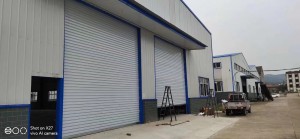Number of times the fast rolling door is used
In the modern industrial landscape, efficiency and speed are of the essence. One of the innovations that has made a significant contribution to achieving these goals is the fast rolling door. These doors are designed to open and close quickly, providing a seamless transition between different areas of the facility. As the industry continues to evolve, understanding the number of times a rolling shutter door is used can provide valuable insights into operational efficiency, safety and energy savings.
What is a fast rolling door?
A fast rolling door, also known as a high-speed door, is a special door that operates at a much higher speed than traditional doors. They are typically made from durable materials such as PVC or aluminum and are designed to withstand harsh industrial environments. These doors open and close in seconds, making them ideal for high-traffic areas where time is of the essence.
Main features of fast rolling shutter doors
- Speed: The opening and closing speed of fast rolling shutter doors is up to 100 inches per second, significantly reducing the waiting time of people and vehicles.
- Durability: Made from sturdy materials, these doors can withstand frequent use and harsh conditions, making them ideal for warehouses, manufacturing plants, and distribution centers.
- Energy Efficiency: By minimizing the time the opening is exposed to the outside environment, fast rolling doors help maintain temperature control and reduce energy costs.
- Safety Function: Many fast rolling shutter doors are equipped with safety sensors and emergency stop functions to ensure the safety of personnel and equipment.
- Customizability: Rapid rolling doors can be customized to specific sizes and operational needs, making them suitable for a variety of applications.
Frequency of use: a key indicator
The number of times a rolling shutter door is used can vary greatly depending on the type of facility, the nature of the operation and the volume of traffic. Understanding this frequency is critical for several reasons:
1. Operational efficiency
In high-traffic environments, fast rolling doors can be used hundreds or even thousands of times a day. For example, in a distribution center, these doors may open and close multiple times per hour as goods come in and out. Tracking frequency of usage can help facility managers identify peak operating times and optimize workflows accordingly.
2. Maintenance and lifespan
The more frequently a rolling shutter door is used, the more wear it will experience. Regularly monitoring usage can help schedule maintenance and repairs to ensure your doors remain in optimal working order. This proactive approach extends the life of your door and reduces the chance of unexpected failure.
3. Security and Compliance
Frequent use of rolling shutters can increase the risk of accidents if not managed properly. By tracking how often these doors are used, security managers can implement the necessary training and security protocols to minimize risk. Additionally, compliance with safety regulations can be better maintained when usage data is available.
4. Energy consumption
Rapid rolling doors help save energy by reducing the time the opening is exposed to the outside environment. However, if the door is used frequently, it can lead to increased energy consumption if not managed properly. Monitoring usage can help facility managers assess the energy efficiency of their operations and make necessary adjustments.
Case study: Use of fast rolling shutter doors in different industries
1. Warehousing and distribution
In large distribution centers, fast rolling doors are often used to facilitate the movement of goods between loading docks and storage areas. Research shows that during peak operations, a fast rolling door can open and close more than 1,000 times a day. This high frequency of use emphasizes the importance of having reliable and efficient doors to maintain workflow.
2. Food and beverage industry
In food processing plants, fast rolling doors are essential to maintain hygiene and temperature control. These doors are often used to separate production areas from storage and shipping areas. In one facility, roller shutters were recorded being used more than 800 times a day, underscoring their role in ensuring smooth and efficient operation while adhering to strict safety and hygiene standards.
3.Automobile manufacturing
In automotive manufacturing, fast rolling doors are crucial for moving parts and vehicles between different production stages. A factory may use its rolling shutters more than 1,200 times a day, underscoring the need for speed and efficiency in a highly competitive industry. The ability to quickly change between zones can significantly impact production schedules and overall output.
Conclusion: The future of fast rolling shutter doors
As the industry continues to develop, the demand for high-speed rolling shutter doors is expected to grow. The ability to track and analyze the number of times these doors are used will become increasingly important to optimize operations, ensure safety and maximize energy efficiency.
Investing in high-speed roller doors not only improves operational efficiency, but also helps create a safer, more sustainable work environment. As technology advances, we can expect to see more innovations in the design and functionality of fast rolling doors, further solidifying their place in modern industrial operations.
In summary, the frequency of rapid rolling door use is a key metric that can provide valuable insights into operational efficiency, maintenance needs, safety protocols and energy consumption. By understanding and monitoring this usage, businesses can make informed decisions that make their operations more productive and sustainable.
